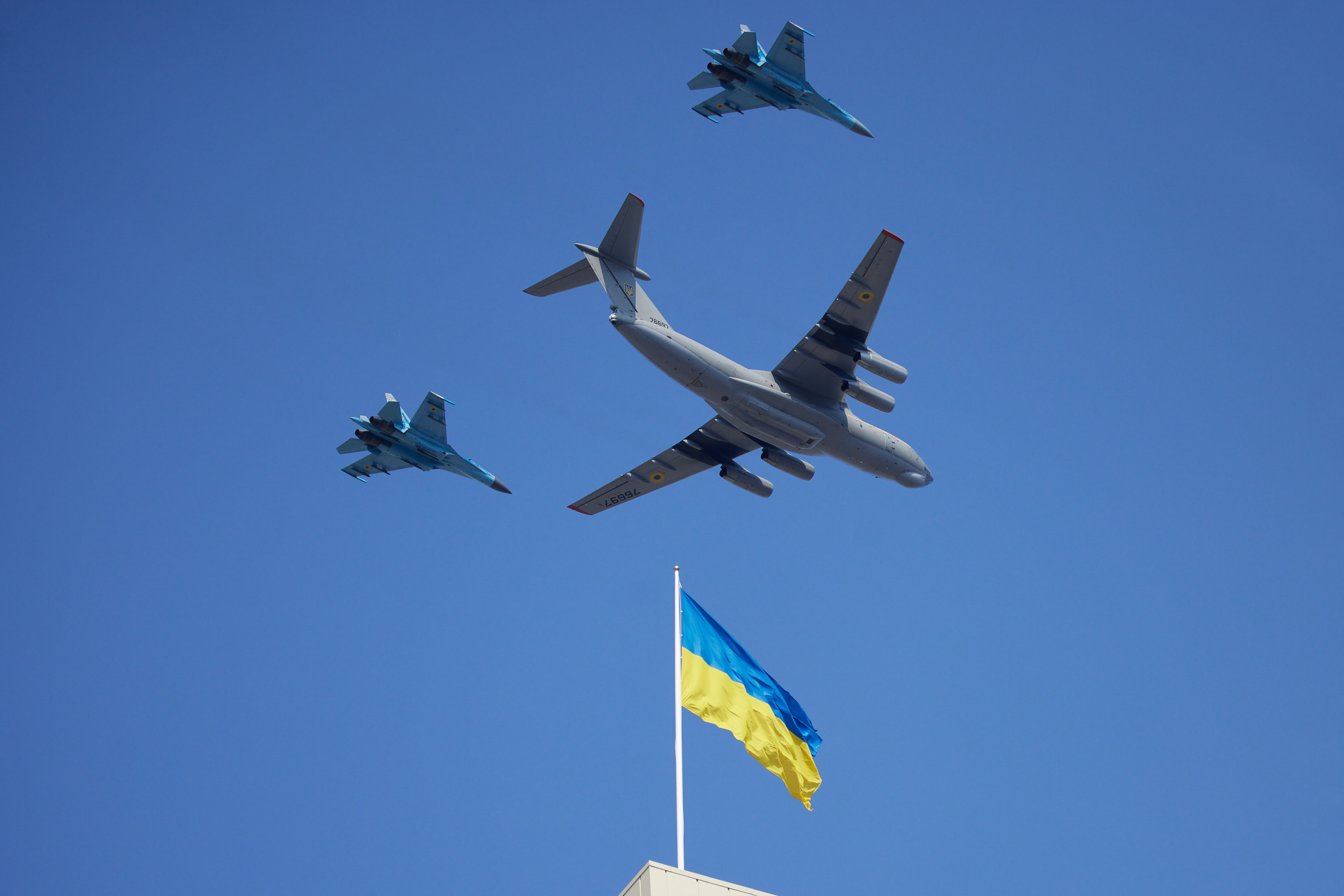The False Promise of Nuclear Deterrence for Postwar Ukrainian Security

Published by The Lawfare Institute
in Cooperation With

Editor’s Note: One of the most frightening possibilities of the Russia-Ukraine conflict is that it increases the risk of nuclear war. This risk, however, doesn’t necessarily end once the shooting stops. Cornell University professor Matthew Evangelista explores the implications of extending the nuclear umbrella to Ukraine and argues that the world would be better off without such a shield.
Dan Byman
However and whenever Russia’s brutal war against Ukraine ends, Ukrainians will need a postwar security policy. Their choice holds implications for European security more broadly. Some observers, and many Ukrainians, anticipate Ukraine’s eventual membership in the North Atlantic Treaty Organization. As a NATO member, Ukraine would benefit from the ostensible protection afforded by “extended nuclear deterrence”—the prospect that the United States might respond to an attack against a NATO ally, even carried out with only conventional forces, by a retaliatory strike with nuclear weapons against the attacker. Others find the proposal for Ukraine to join NATO dubious or undesirable, and some question the credibility of the extended-deterrent threat or worry that it increases the risk of unintended escalation to global nuclear war. The best thing for postwar Ukraine, however, would be to avoid tying its security to nuclear weapons—its own or NATO’s. Instead, it should focus on ensuring its conventional forces are robust and defensively oriented, adequate to deter but not to provoke another Russian attack.
One might have expected Russia’s February 2022 invasion to have shaken confidence in the view that nuclear weapons foster an overall peace. Granted, Ukraine received no extended-deterrent promise from the United States (even though the Budapest Memorandum, signed when Ukraine agreed to relinquish the Soviet nuclear weapons held on its territory after the dissolution of the USSR, offered “security assurances”). Still the proponents of nuclear weapons had touted their contribution to maintaining the peace, beyond the countries explicitly sheltered under the U.S. nuclear umbrella. In 1987, for example, British Prime Minister Margaret Thatcher criticized Soviet reformer Mikhail Gorbachev’s advocacy of nuclear disarmament—a view he shared with the nuclear abolitionist Ronald Reagan. Thatcher asserted, by contrast, that “we do not believe that it is possible to ensure peace for any considerable amount of time without nuclear weapons. Nuclear weapons are the most powerful and most terrible guarantee of peace that was invented in the 20th century. There is no other guarantee.” Thirty years later, in July 2017, 122 countries meeting at UN headquarters in New York City voted in favor of a legally binding treaty to ban nuclear weapons. The nuclear-armed members of NATO—the United States, the United Kingdom, and France—vowed never to sign or ratify the treaty, which entered into force in January 2021. “Accession to the ban treaty,” they argued, “is incompatible with the policy of nuclear deterrence, which has been essential to keeping the peace in Europe and North Asia for over 70 years.” In making this claim, they were echoing not only Thatcher but also Vladimir Putin, who had stated in October 2016 that “nuclear weapons constitute a factor of deterrence and a factor guaranteeing peace and security throughout the whole world.” On the contrary, it is possible that Russia’s nuclear arsenal enabled the attacks of both 2014 and 2022, with Putin confident that it would deter NATO from coming to Ukraine’s defense.
Yet confidence in nuclear deterrence persists, based on the understanding that it prevented Soviet aggression against Europe during the Cold War. In fact, however, this claim is incorrect. Nuclear deterrence was never put to the test in Europe, because there was nothing to deter. What Robert Jervis wrote more than 20 years ago remains true today: “The Soviet archives have yet to reveal any serious plans for unprovoked aggression against Western Europe, not to mention a first strike against the United States.” Instead, the archival documents showed that Soviet military plans immediately following World War II were defensively oriented—with forces arrayed in belts at 50, 100, and 150 kilometers from the inter-German border. Only with the deployment to NATO Europe of tactical nuclear weapons in the early 1950s did the Soviet Army adopt an offensive orientation. The introduction of U.S. nuclear weapons into Europe did not enhance security but, rather, fostered instability and raised the risk of war.
Extended nuclear deterrence brought the continent to the brink of nuclear catastrophe in September 1961 during the Berlin Crisis—a lesson on the nuclear umbrella’s risks that bears pondering today. The Vienna summit of June 1961 failed to settle the anomalous situation of West Berlin—a democratic outpost surrounded by communist East Germany and hundreds of thousands of Soviet troops—and secure a peace treaty that would formally recognize the postwar borders. Soviet leader Nikita Khrushchev vowed to pursue his Plan B: a separate treaty with East Germany that would allow its leaders to determine access to Berlin, which they had declared its capital. NATO officials developed plans to deploy military force to ensure access to the city in the event the communist regime tried to deny it. The NATO secretary general declared that “the Alliance will stand ready for nuclear action at all times[,]” including a provision “to employ nuclear weapons selectively in order to demonstrate the will and ability of the Alliance to use them.”
The notion of employing nuclear weapons for signaling purposes owes much to the work of RAND strategist Thomas Schelling, who drafted a memorandum advocating such “nuclear bargaining” over Berlin in June 1961. According to McGeorge Bundy, national security adviser to President Kennedy, the memorandum made a “deep impression” on the president when he read it on Bundy’s recommendation. Meanwhile, other Kennedy advisers, such as Paul Nitze, were advocating that the United States use its nuclear weapons preemptively to attempt a disarming first strike against the Soviet Union if access to Berlin were blocked. As he described in his memoir, Nitze told the president that a U.S. first strike “could assure us victory in at least a military sense in a series of nuclear exchanges, while we might well lose if we allowed the Soviets to strike first.” The cost would be 9-10 million U.S. casualties in a retaliatory strike by the surviving Soviet weapons, but the other side would suffer 10 times that number, according to Nitze’s calculations.
What was not known at the time, but has been discovered since in Soviet bloc military plans, is that the Soviet armed forces were training to respond to preparations for a NATO nuclear strike with massive nuclear preemption, intended to destroy the NATO weapons before they could be used. Notions of nuclear bargaining, signaling, and graduated escalation were artificial constructs in the minds of U.S. strategists but bore no relationship to how the other side might actually respond.
No wonder prominent US officials, as well as their European counterparts, harbored doubts about the credibility or plausibility of NATO’s reliance on nuclear weapons. Henry Kissinger, national security adviser to President Nixon in early 1969, for example, averred that extended nuclear deterrence “depended on a first strike” by the United States, something he claimed the European allies did not understand. Nixon concurred. The “nuclear umbrella in NATO” was, according to the president, “a lot of crap.”
Is the situation any different today? No one knows how Russian leaders would react to NATO’s threat or use of nuclear weapons—but probably not according to hopeful scenarios of “escalation dominance” that foresee U.S. forces prevailing at each step of the “ladder of escalation” and Russian leaders, clearly anticipating an unfavorable outcome, backing down in advance.
Along with other skeptics of the U.S. nuclear umbrella, I consider a conventional military strategy for Ukraine, such as the one designed by Barry Posen as early as 1994, more promising. It shares elements of ideas developed by European peace researchers during the Cold War to provide defensively oriented conventional forces that were sufficiently dispersed so as not to offer targets for nuclear strikes. Current versions fall under the rubric of “confidence-building defense” and include such strategies as the “spider-in-the-web.” These nonoffensive defense strategies were designed not to threaten the other side and risk provoking an attack during periods of tension. Historical examples include the decentralized, militia-based territorial defense systems of Switzerland, Yugoslavia, Sweden, and Finland. Their forces were suited to defending their territories but not seizing and occupying the territory of their neighbors. For postwar Ukraine, such a system would mean clearly relinquishing an ability to regain any territory lost to Russia—a prerequisite for a stable peace, however unjust. Adopting such a territorial defense strategy would not require a declaration of neutrality and would not preclude cooperation with NATO countries in the provision of conventional weapons, for example, so long as they did not pose an offensive threat to Russia that could provoke it to resume the war. Combining a defensive orientation for Ukrainian military forces with well-prepared mass civilian resistance to occupation—a technique attempted spontaneously with some success in the first months of the 2022 invasion—could serve as a deterrent to aggression, without risking the catastrophic consequences of nuclear escalation.
However much Ukraine’s supporters would prefer an end to the war that would leave the country with its pre-2014 borders intact, a more likely outcome would entail a territorial compromise. Under those conditions, a postwar Ukrainian security policy should be oriented toward robust defense without providing any pretext for renewed Russian aggression. Nuclear deterrence offers no panacea but, rather, incalculable risks. Postwar Ukraine should forswear, not covet, a “nuclear umbrella.”





